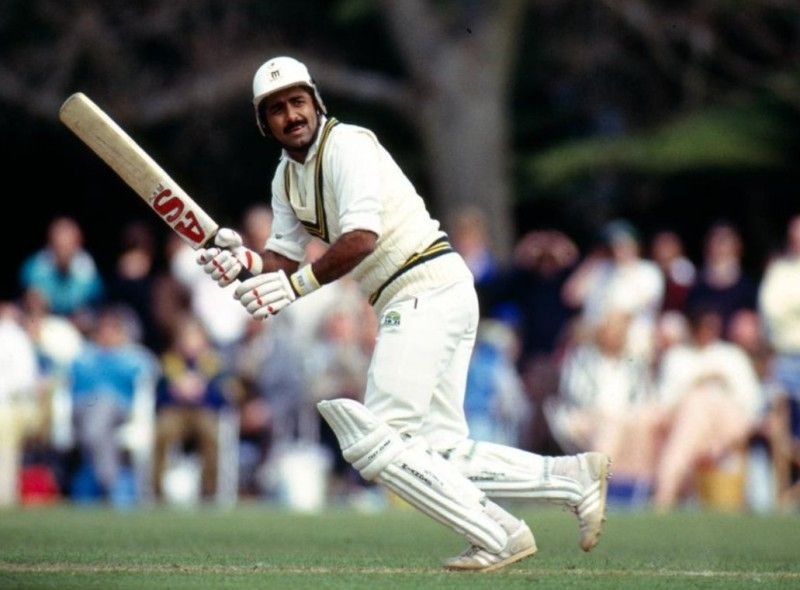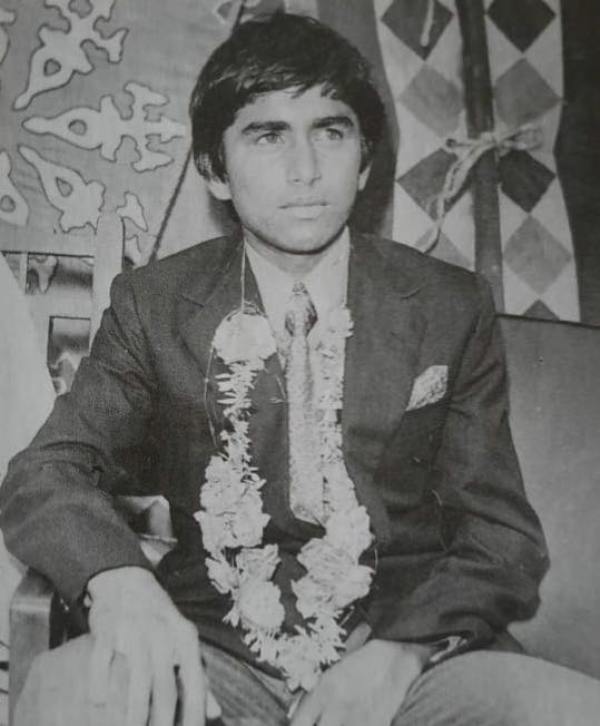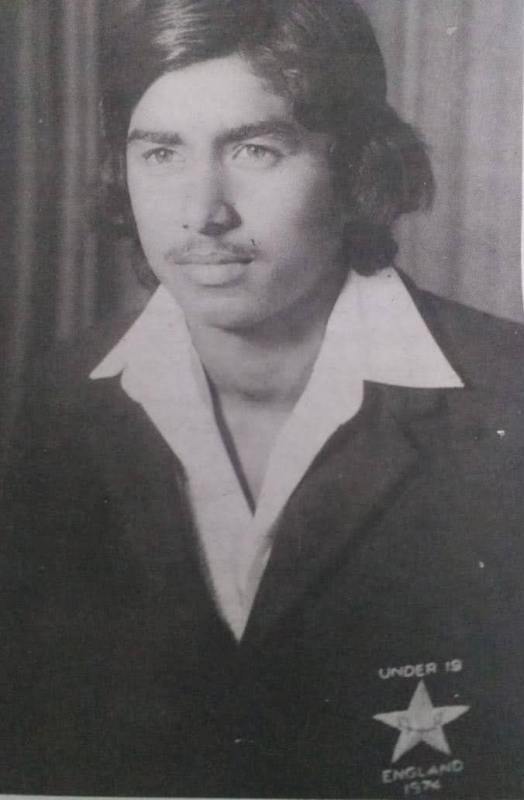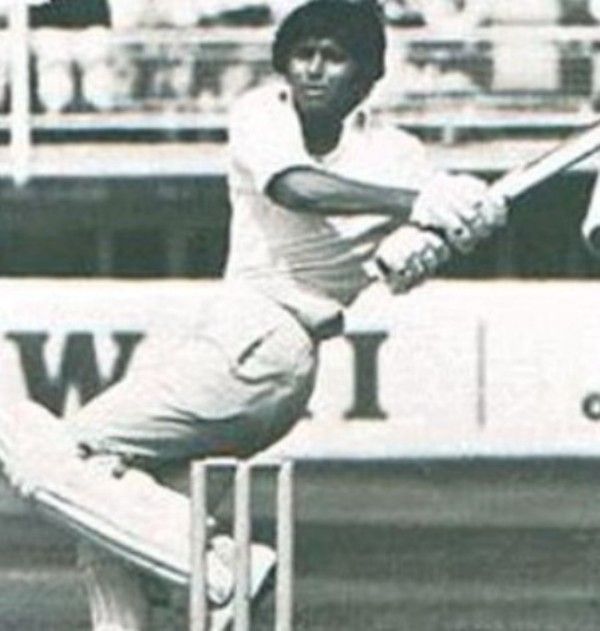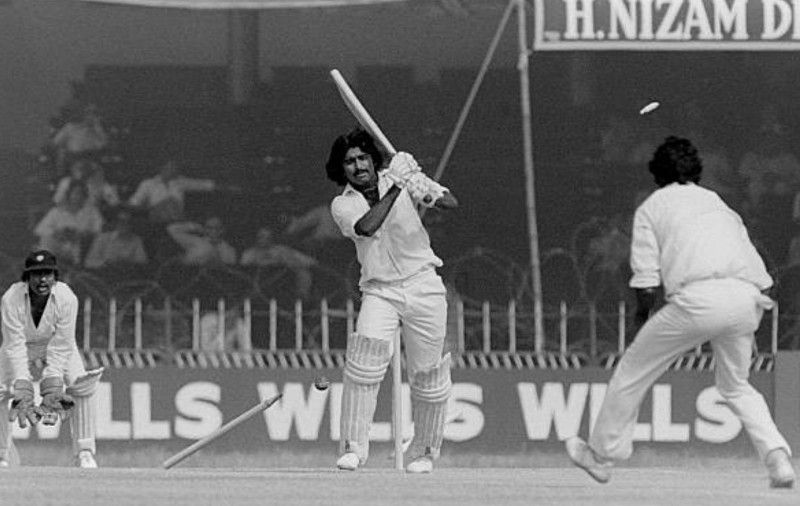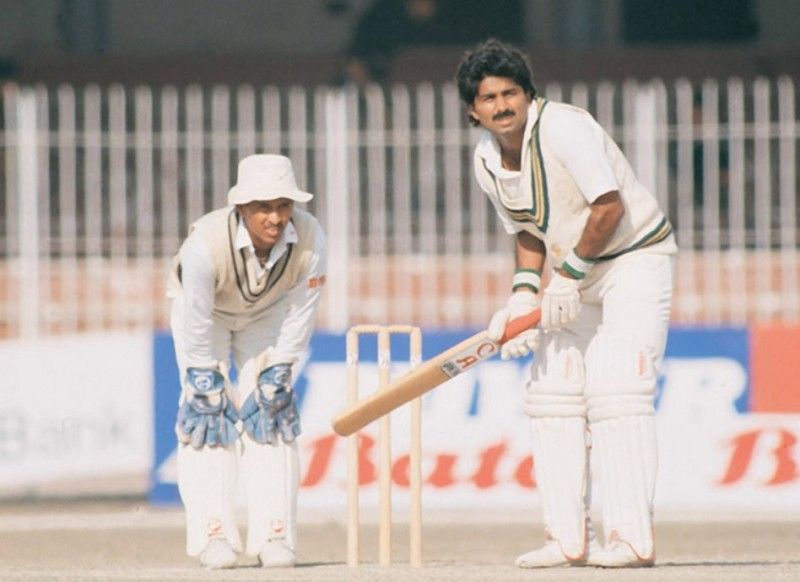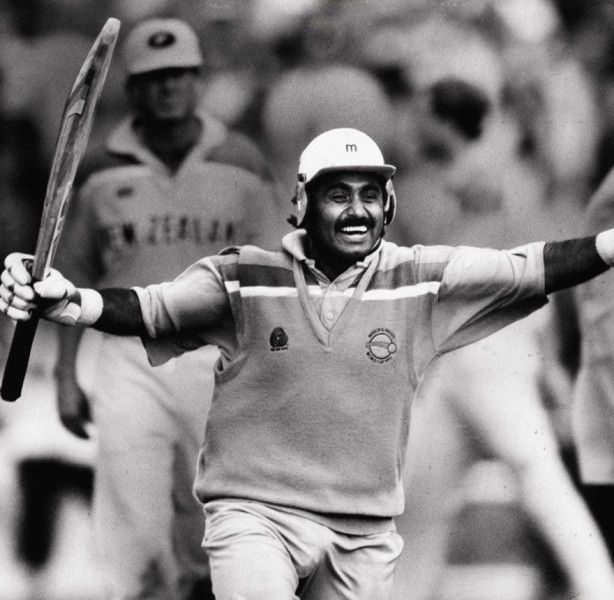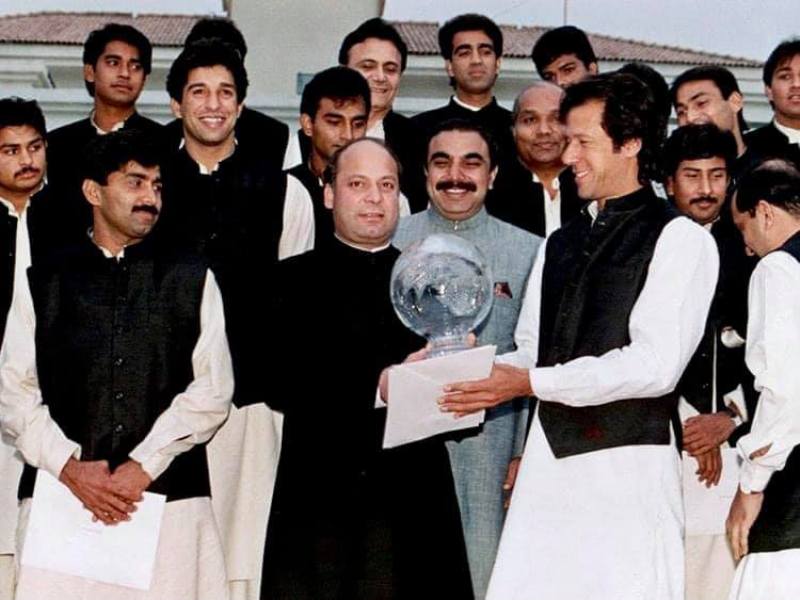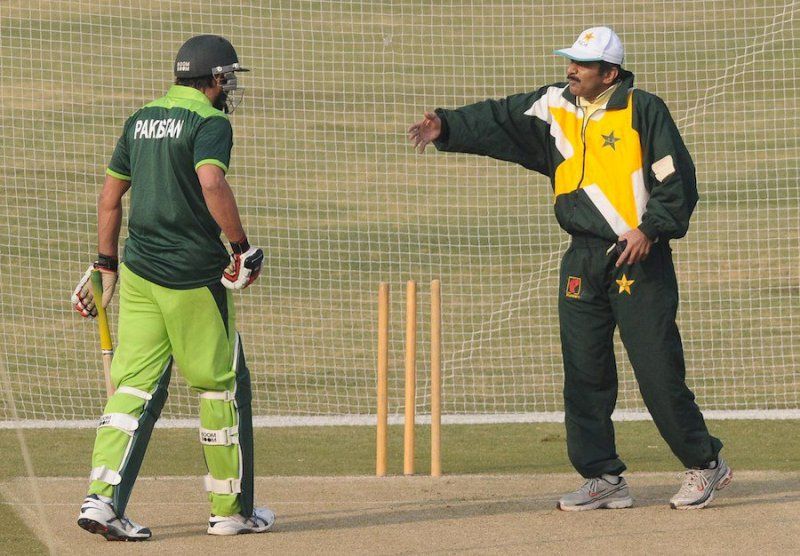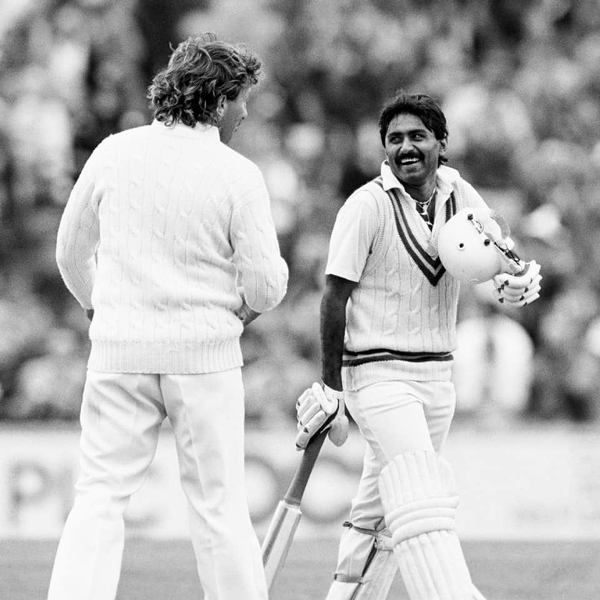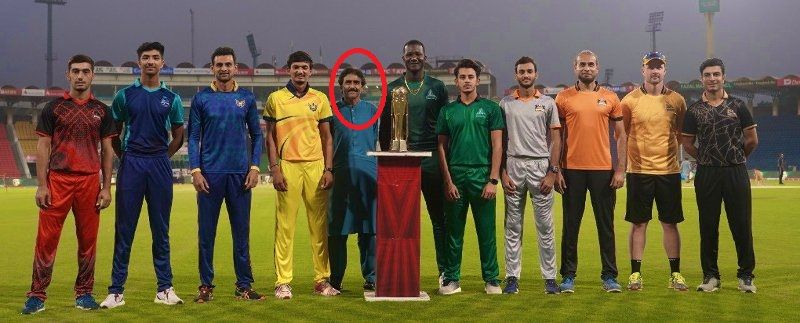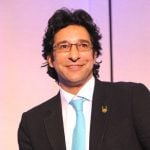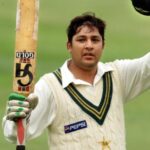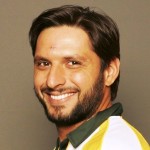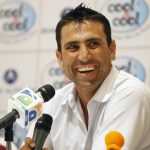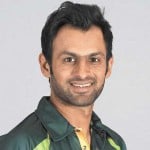Javed Miandad Height, Age, Wife, Children, Biography & More
| Bio/Wiki | |
|---|---|
| Nickname | Karachi Streetfighter |
| Profession | Cricketer (Batsman) |
| Famous for | Hitting six on the last ball of Chetan Sharma in the 1986 Austral-Asia Cup Final |
| Physical Stats & More | |
| Height (approx.) | in centimeters- 172 cm in meters- 1.72 m in feet & inches- 5’ 8” |
| Weight (approx.) | in kilograms- 70 kg in pounds- 154 lbs |
| Eye Colour | Black |
| Hair Colour | Black |
| Cricket | |
| International Debut | ODI- 11 June 1975 against West Indies at Edgbaston Cricket ground, Birmingham, England Test- 9 October 1976 against New Zealand at Gaddafi Stadium, Lahore, Pakistan |
| International Retirement | He retired from test cricket in 1993 and from ODIs after the 1996 World Cup. |
| Last Match | Test- 16 December 1993 against Zimbabwe at Gaddafi Stadium, Lahore, Pakistan ODI- 9 March 1996 against India at M Chinnaswamy Stadium, Bengaluru, India |
| Batting Style | Right-handed |
| Bowling Style | Right-arm leg break |
| Batting Stats | Runs • Test He played 124 matches in which he scored 8832 runs in 189 innings with an average of 52.57; his highest score was 280 runs not out. He scored 6 double centuries, 23 centuries, and 43 half centuries, and he hit 704 fours and 34 sixes. • ODI He played 233 matches in which he scored 7381 runs with an average of 41.70 and strike rate of 67.01; his highest score was 119 runs not out. He scored 8 centuries, and 50 half centuries, and he hit 449 fours and 44 sixes. He faced 11014 balls. |
| Bowling Stats | Wickets • Test He played 124 matches in which he took 17 wickets. With an average of economy of 2.78, he gave 682 runs. He delivered 1470 balls. His best bowling in a match was 3/74, and his best bowling in an inning was 5/94. • ODI He played 233 matches in which he took 7 wickets. With an economy of 4.09, he gave 6850 runs. He delivered 436 balls. His best bowling in a match was 2/22. |
| Fielding Stats | • Test There are 93 catches to his name. • ODI There are 70 catches to his name. |
| Domestic/State Team | • Sind • Habib Bank Limited • Sussex • Glamorgan • Pakistan |
| Records (main ones) | • Only Test player whose career batting average never went below 50 • Only batsman to score a century in his 1st and 100th test • Second-highest run-scorer (8832 runs) for Pakistan in test cricket • Played most test matches (124 tests) for Pakistan • Highest batting average (52.57) for Pakistan in test cricket • Highest career runs (3730 runs) in the first innings of a test match for Pakistan • Most consecutive half-centuries (9) in ODI cricket • First Pakistani batsman to score 1000 runs in a calendar year (1987) in ODI cricket • Youngest player to score a double century in tests • Second Pakistani player to score a century on his test debut • Fastest Pakistani player to score 2000 test runs (42 innings) • Fastest Pakistani player to score 3000 test runs (67 innings) • Fastest Pakistani player to score 4000 test runs (84 innings) • Second fastest Pakistani player to score 5000 test runs (107 innings) • First Pakistani batsman to score 6000 test runs, 7000 test runs, and 8000 test runs • First Pakistani batsman to score 5000 ODI runs (139 innings) • First player to play in 6 World Cups (1975-1996) |
| Awards, Honours, Achievements | • Pride of Performance, awarded by the Government of Pakistan, in 1986 • Sitara-i-Imtiaz award, the third-highest civilian honour in Pakistan, in 1992 • Inducted into the ICC Cricket Hall of Fame on 1 March 2009 • Inducted into the Pakistan Cricket Board Hall of Fame 2021 |
| Personal Life | |
| Date of Birth | 12 June 1957 (Wednesday) |
| Age (as of 2023) | 66 Years |
| Birthplace | Karachi, Pakistan |
| Zodiac sign | Gemini |
| Signature |  |
| Nationality | Pakistani |
| Hometown | Karachi, Pakistan |
| Religion | Islam |
| Food Habit | Non-vegetarian |
| Controversies | • Fight with Dennis Lillee [1]The Roar A fight happened between him and Dennis Lillee during the 1981-82 Pakistan tour of Australia, which was his first tour outside Pakistan as a captain. On the fourth day of the first test on 16 November 1981, he was batting to chase the mammoth target of 543 runs given by Australia. He hit a shot and ran to take a single when Lillee unknowingly obstructed him. He shoved Lillee to complete his single, who then kicked him on his pad. Miandad raised his bat to hit him; however, the umpire Tony Crafter stopped Lillee from moving towards Miandad. Then-Australian captain Greg Chappell intervened and pacified Lillee. Lillee walked away, but he turned around to hit Miandad; however, Crafter and Chappell again stopped him. Lillee was banned for 2 ODIs and fined AU$ 120 after the incident. Lillee talked about the incident in an interview that said that Miandad hit him in the ribs first, and the replays did not show the full incident. He said, "Javed jabbed me in the rib cage with his bat, but nobody wanted to know about it. I’m not saying I was right in what I did, even though I gave him only a slight tap on the field. I’m sorry thousands of kids saw it, but I’m also sorry the incident wasn’t fully shown in television replays." Miandad also talked about this incident in an interview and said that he told Lillee that he would hit him if he would keep on hurling abusive slurs at him. He said, "I lifted my bat to ward him off and to tell him that if he hit me, I’d hit him for saying dirty words to me." 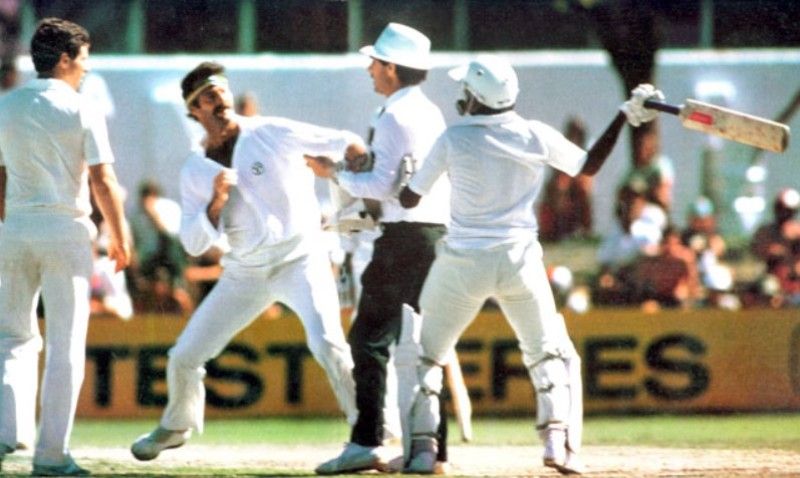 • Sneering Indian Wicketkeeper Kiran More in the 1992 World Cup [2]The Telegraph [3]Hindustan Times A comical exchange of gestures occurred between Javed and Kiran More, then-Indian wicketkeeper, on 4 March 1992 during the clash between both teams in the 1992 World Cup at Sydney Cricket Ground, Sydney, Australia. The match was reduced to 49 overs each side, and India gave a target of 217 runs to Pakistan. Javed came to bat when Pakistan's score was 17 runs for 2 wickets. Sachin Tendulkar was bowling the 24th over, and on the fifth ball of the over, the umpire rejected Kiran's appeal for a catch out. Javed turned around, said a few words to Kiran, and signalled the umpire to stop Kiran from talking to fellow Indian players. Kiran again appealed for a run out on the final delivery of the over; however, Javed returned back to the crease in time, and did three jumps holding his bat in both hands to mock Kiran. Kiran put his hands on his mouth as a response. Javed was warned by the umpire David Shepherd who said that he would send him out of the ground if he repeated this. Javed and Kiran later became good friends. Javed talked about this incident in an interview and said that Kiran's constant chatter with the fellow Indian players were disturbing him, and he was not able to focus. He said, "Many people, myself included, remember that match for a testy exchange that went on between the Indian wicketkeeper, Kiran More, and me. His frequent appealing was bad enough, but it was the constant chatter he kept up whenever he wasn’t appealing that got to me. He would go on about what the Indians were going to do, how they were going to overwhelm us and how all my efforts were going to amount to nothing. It was all delivered in rather colourful Urdu, and it was making it impossible for me to concentrate. I finally turned around and confronted More. Talk and appeal all you want, Kiran, but stay quiet once the bowler has taken his start and I have settled into my stance. For a while after that, More put a lid on it, but then he started again. It was extremely annoying. Obviously, words — from myself as well as from one of the umpires — hadn’t got through to More. So, I decided to make fun of his antics and jumped around the wicket like a kangaroo to ape how excitable he had become. It was captured by all the (TV) cameras and by a number of photographers. It became one of the images of the 1992 World Cup." Kiran also talked about this incident in an interview and said that he wanted to pressurise Javed by guiding bowlers about how to bowl to him. He said, "Javed (Miandad) had a back injury. I kept on telling the bowlers, bowl it up to him, don’t bowl short to him. If you bowl it short, even with his back problem, it will be easy for him to play the cut shot. So he was getting frustrated. He was trying to drive the ball to mid-off and cover, but the ball was not going. In Hindi, he was saying that, ‘don’t worry we will win this match easily’. And I said, ‘go to hell, we will win this match’. And there was an appeal down the leg-side off Sachin Tendulkar. I thought he was caught behind. I appealed and Javed swore at me. I told him to shut up, he told me the same. Then, there was a run-out appeal when I jumped and whipped the stumps. And he started imitating me. I gave it back to him. I covered my mouth with my gloves. That's the time when the mike was used. Umpire David Shepherd came in and told Javed, if you do it again, I’ll send you out of the ground. After that, I went to Pakistan. Javed called me. I went to his house for dinner. Till 4 in the morning we had a great time, a great laugh." 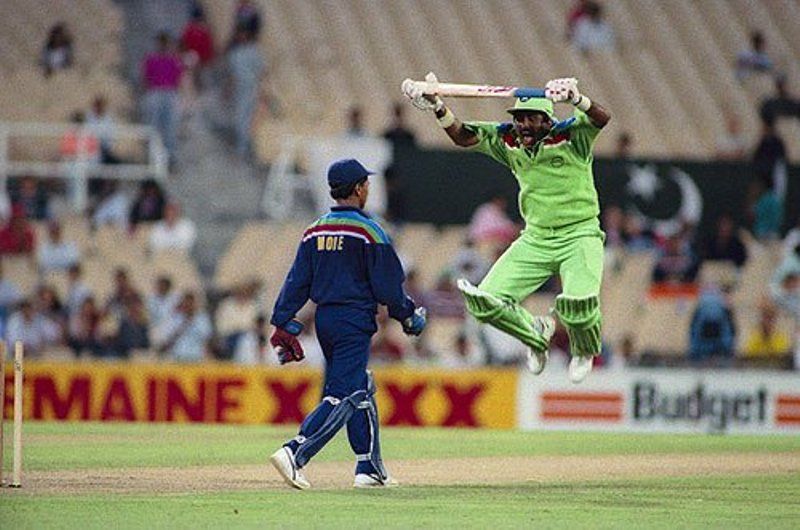 • Brandishing sword at a Pro-Kashmir Rally [4]The Tribune He participated in a pro-Kashmir Pakistani rally in September 2019, brandished a sword, and expressed his support for Kashimiri separatists. He said, "Kashmiri brothers don't worry. We are with you. Earlier I used a bat to hit a six, now I can use this sword. If I can hit a sixer with a bat, can't I kill a man with a sword. I will go to the border for peace. I will call all the top people, the sports people and everyone. I will go there and tell everyone about peace. I will go with a peace flag. I will tell people that we want peace and we are with the Kashmiri people." • Urging ICC to Stop Tours to India [5]DNA He requested ICC to stop teams from touring India to play cricket, citing the protests against the Citizenship Amendment Act (CAA) in various parts of India in December 2019. His statement angered Indian cricket fans, who posted angry and sarcastic replies on Twitter and other social media. In an interview, he talked about the CAA protests and said, "People should take note of what is going on in India. I urge the ICC to boycott them. Not Pakistan but India is not a safe country for any tourist or anybody (sic). As human beings, we sportspersons should also stand up and condemn them." |
| Relationships & More | |
| Marital Status | Married |
| Affairs/Girlfriends | Tahira Saigol |
| Marriage Date | Year: 1981 |
| Family | |
| Wife/Spouse | Tahira Saigol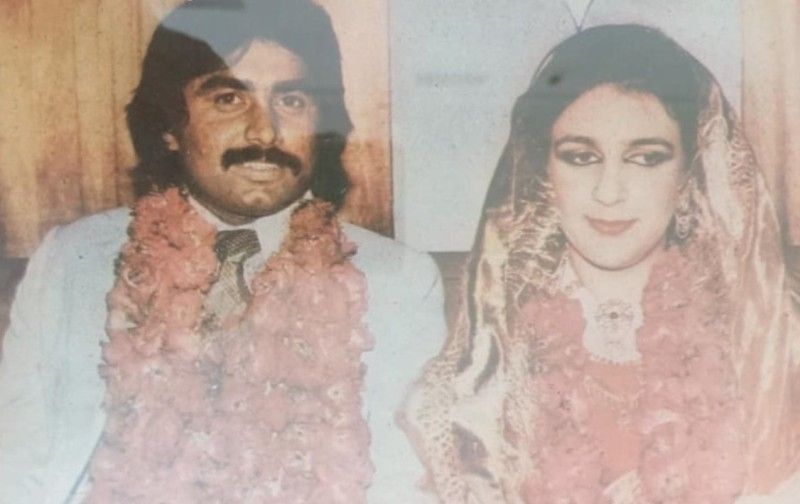 |
| Children | He has one daughter and two sons. One of his sons is named Junaid Miandad.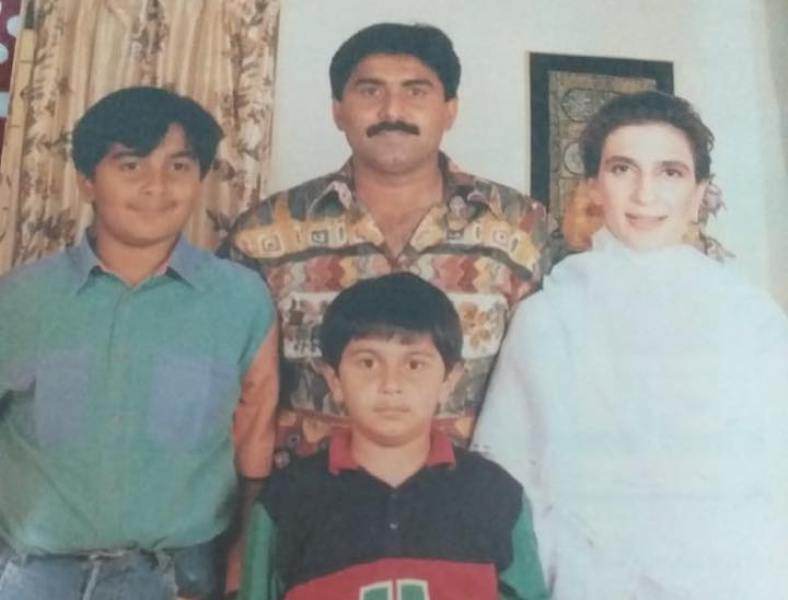 |
| Parents | Father- Noor Mohammad Miandad (Intelligence Officer and office-holder in the Karachi Cricket Association) Mother- Name not known 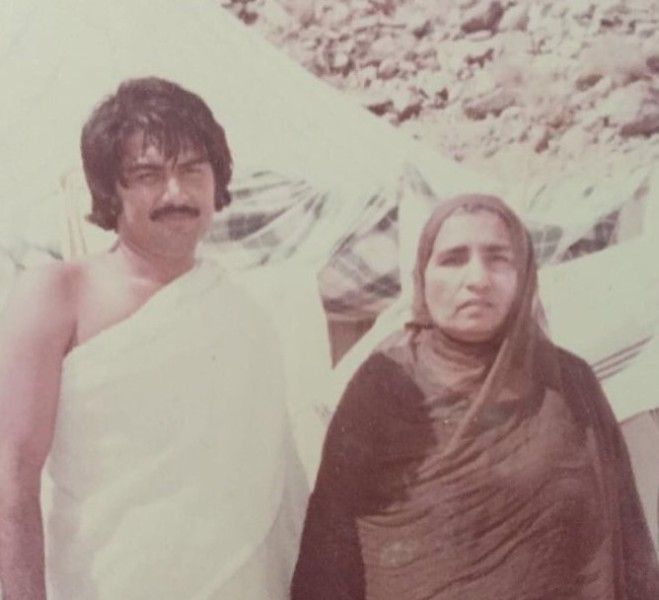 |
| Siblings | Brother- 4 (Anwar Miandad, Bashir Miandad, Sohail Miandad, and Hamif Miandad) Sister- 1 (Safia Iqbal) 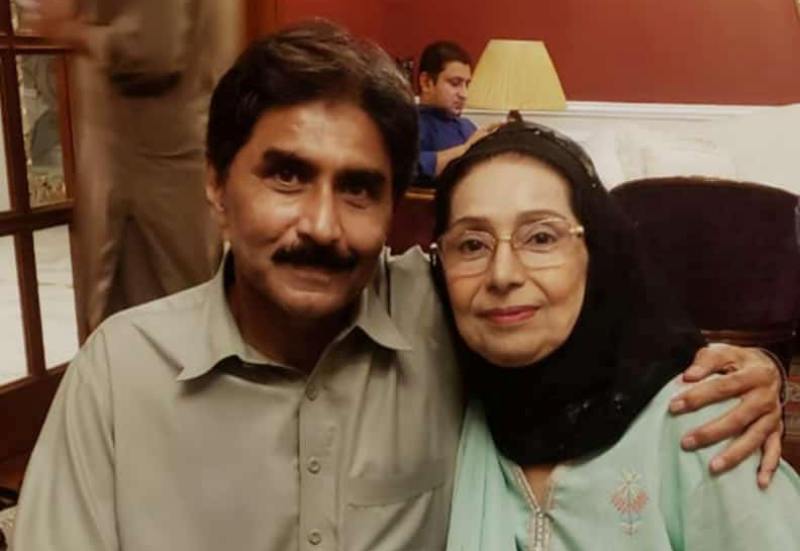 |
| Other Relatives | • Faisal Iqbal (Nephew) (Cricketer) • Khalid Saigol (Father-in-law) • Farida Hayat (Mother-in-law) • Mahruk Ibrahim (Daughter-in-law) 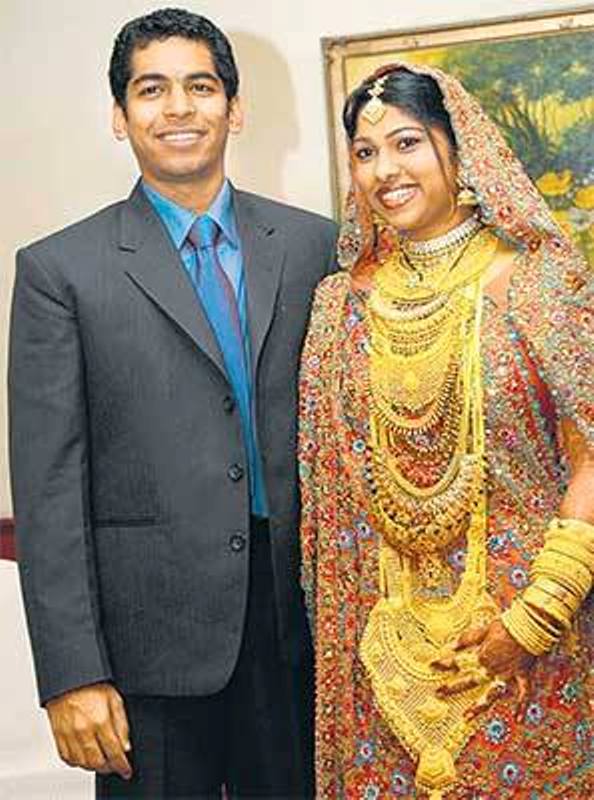 • Dawood Ibrahim ( Son's Father-in-law) |
Some Lesser Known Facts About Javed Miandad
- Javed Miandad is a retired Pakistani cricketer who has represented Pakistan in six World Cups. He has made many records for Pakistan and helped them to win the 1992 World Cup. He is regarded as one of the finest cricketers Pakistan has ever produced. He also served as the coach of the Pakistani national team.
- During the Partition of India in 1947, his family migrated to Karachi, Pakistan from Ahmedabad, Gujarat, India.
- He grew up in a cricket-loving family, and his father was also a cricketer, who was an intelligence officer in the police department in Baroda (now Vadodara) before India’s Partition. He became a grader at the Karachi Cotton Exchange after moving to Karachi and later became the secretary of the Muslim Gymkhana and an office-holder in the Karachi Cricket Association. [6]The Telegraph
- He initially started playing cricket at the Muslim Gymkhana in Karachi, Pakistan, where he played many matches only as a fielder to spend time with national players. He earned Rs 50 per match and honed his skills while playing in these local competitions.
- He became popular in these competitions when he hit three sixes off the last three balls to win the match for his team which needed 16 runs to win the match.
- He played in the 1974 Under-19 World Cup held in England.
- In a match of the 1975 Kardar Summer Shield Trophy, he scored 311 runs which became his highest first-class score. His knock caught the attention of Abdul Hafeez Kardar, Pakistan’s first test captain and widely respected administrator of Pakistani cricket, who called him the find of the century.
- He scored 163 runs in his first innings of test cricket while playing against New Zealand and became the second Pakistani batsman to score a century on his test debut.
- In the third test of his career, he scored 206 runs against New Zealand and became the youngest player to score a double century in tests.
- In the 1978-79 series against India, he completed 1000 test runs and became the second-youngest batsman to score 1000 test runs at that time.
- In the 1979-80 series against India, he completed 2000 test runs and became the fastest Pakistani batsman to achieve this feat (42 innings).
- He captained Pakistan for the first time in the 1979-1980 series against Australia.
- In the 4th test during the 1982-83 series against India, he put up a partnership of 451 runs for the 3rd wicket with Mudassar Nazar, which became the world record for the 3rd wicket partnership and equalled the world record for any test wicket at that time. This was the first partnership for Pakistan in which both batsmen scored double centuries; Javed scored his career-best test score of 280 runs not out.
- In the 1982 series against Sri Lanka, he completed 3000 test runs and became the fastest Pakistani batsman to achieve this feat (67 innings).
- In the 1983 tour of India, he completed 4000 test runs and became the fastest Pakistani batsman to achieve this feat (84 innings).
- He displayed the witty side of his personality when Ravi Shastri was batting during the Indian chase in the final of the 1985 Benson & Hedges World Championship of Cricket. He asked Ravi Shastri why he was looking at the Audi 100 car and said that Shastri would not get the car. India chased down the target of 177 runs and won the tournament. Shastri was adjudged man of the tournament and won an Audi 100 car.
- Ravi Shastri later talked about that incident and said that he also replied to Javed and said that the car was coming his way. He said,
We needed some 15-20 runs more to beat Pakistan in the final of the 1985 Benson & Hedges tournament. I had a look at square-leg to check the field set by Javed Miandad, Pakistan’s captain. Javed perked up from midwicket. Tu baar baar udhar kya deke raha hai” (Why are you looking there repeatedly?) he said in his characteristic lisp. “Gaadi ko kyun dekh raha hai?!” (Why are you looking at the car). Voh nahi milne waali hai tere ko! (You are not going to get it!) That’s when I had one proper look at it, and told him, “Javed, meri taraf hi aa rahi hai! (It’s coming my way, only!)” [7]Times Now
- Three unfortunate incidents occurred during the 1985-1986 Pakistan tour of Sri Lanka, which violated the spirit of the game. First, the umpire started rubbing the new ball which was taken only after 16 overs of Pakistani batting to stop it from swinging; second, Javed fought with the umpire over his dismissal; third, a fan threw a stone at Javed who in turn went into the stands to beat him. These protests outraged Pakistani players who refused to play further series; however, Pakistani President Zia-ul-Haq intervened and persuaded the players to continue the series.
- In the 1985 tour of New Zealand, he completed 5000 test runs and became the fastest Pakistani batsman to achieve this feat (107 innings), a record which was later broken by Younis Khan.
- He became a household name on 18 April 1986 by hitting six off the last ball of Chetan Sharma to help Pakistan win the 1986 Austral-Asia Cup. India gave a target of 246 runs to Pakistan which lost 2 wickets for 39 runs during the chase. He kept scoring runs at a steady pace to steer the chase with 4 runs needed off the last ball. Chetan Sharma, then only 18 years old, tried to bowl a low yorker; however, Javed anticipated this and stood a few inches ahead of the crease, which turned the delivery into a low full toss, and he hit it for a six, helping Pakistan to win the tournament by one wicket. [8]Hindustan Times
- He became extremely popular as it was one of the earliest occasions when a match was won in that style. He was awarded a Mercedes car, a diamond bracelet worth $80,000, and a promotion at Habib Bank for his match-winning performance of 116 runs off 114 balls at a strike rate of 101.75.
- Then Indian captain Kapil Dev said after the match that this defeat crushed the Indian team’s confidence for the next four years. He said,
When the last over came, we went to Chetan. To this day, I still feel it wasn’t his mistake. They needed 4 runs on the last ball and we decided that it would be a low yorker. There was no other alternative. He tried his best, we all tried. It turned out to be a low full-toss. Miandad kept his backfoot intact and connected it. Even when we remember that today, we can’t sleep. That defeat crushed the whole side’s confidence for the next four years. It was very difficult to make a comeback from there” [9]Times Now
- In his autobiography, Javed mentioned that he expected Chetan to bowl a yorker. He wrote,
I knew that he would try to bowl a yorker, so I decided to stand just ahead of the crease…..poor Chetan Sharma.” [10]CNN-News18
- Chetan Sharma said in an interview later that the cricket fans do not allow him to forget that six, and he went into depression after the match. He said,
I try to forget that six but people do not let me. People do not forget things — either good or bad — that happens during India-Pakistan clashes. People won’t remember the hat-trick against New Zealand in 1987 World Cup or the good performance against England but that Miandad six is one thing they will never forget. No one in the team said anything to me but I myself was upset. That was a very bad phase for me but I overcame that period with the help of my coach Deshprem Azad and friends.” [11]The Times of India
- Pakistani legend Wasim Akram took to Twitter in April 2020 to reveal that Javed hit the six with his bat.
Some moments are etched in ur memory and @I_JavedMiandad hit that epic six against India at Sharjah is 1 of them. It’s a piece of cricket beauties. Whenever you watch it, it gives you real joy and tells how great a batsman he was.BTW the bat from which that 6 was hit was mine😀 https://t.co/T90s0uOgN0
— Wasim Akram (@wasimakramlive) April 18, 2020
- On 6 August 1987, during the 5th test of the England tour, he became the first Pakistani batsman to score 6000 test runs (133 innings).
- In the 1988 series against Australia, he became the first Pakistani batsman to score 7000 test runs (145 innings), and in the 1990 series against New Zealand, he became the first Pakistani batsman to score 8000 test runs (162 innings).
- On 8 January 1989, during a match against Australia in Benson & Hedges World Series, he became the first Pakistani batsman to score 5000 ODI runs (139 innings).
- He tried to persuade the Indian legendary cricketer Sachin Tendulkar to go off the field when the latter was injured while playing in his debut test series against Pakistan in 1989. Apparently, Sachin was hit on the nose by a bouncer bowled by Waqar Younis, and his nose started badly. Javed told Tendulkar that his nose is broken and he needed to visit a hospital. Sachin did not walk off the field and helped India draw the match. [12]Hindustan Times
- He displayed his batting prowess to make Pakistan a world champion by winning the 1992 World Cup held in Australia and New Zealand despite suffering from a stomach infection and back injury and joined the team only two days before the tournament. [13]Gulf News
- He convinced the Pakistani players, who were protesting against captain Imran Khan to play in the tournament. He talked about this in an interview and said,
The revolt took place before the semi-final against New Zealand. But to me, the country was more important and I convinced the players to carry on playing under Imran. Imran retired after winning the World Cup and before the England tour in 1992 because he had come to know about the revolt.” [14]SAMAA ENGLISH
- New Zealand gave a target of 262 runs to Pakistan who lost 2 wickets for 84 runs. He scored 57 runs not out to help them win the semifinal and enter the final.
- He played in the final match despite being infected by an unknown virus, which the doctors also were unable to diagnose. In an interview, he said that he was sweating profusely and was facing trouble batting continuously. He said,
I couldn’t understand what exactly my problem was. I was infected with some peculiar virus because of which I used sweat a lot. I even consulted doctors but my condition towards the end of our innings in the final was such that I couldn’t play a shot, I was just standing there. At the other end, I had Imran (Khan). We forged a partnership and batted the full 50 overs to put up a respectable score.” [15]Hindustan Times
- He scored 58 runs in the final match on 25 March 1992 to help Pakistan post a challenging target of 250 runs to England. Pakistan bowled England all out for 227 runs and became the world champion.
- He made 437 runs in 8 matches at an average of 62.42 with 5 half-centuries which increased his popularity manifold.
- He retired as the highest runscorer in tests for cricket (8832 runs), a record later broken by Younis Khan. He also had the maximum number of test centuries for Pakistan (23) at the time of his retirement, a record broken by Inzamam-ul-Haq, Younis Khan, and Mohammad Yousuf.
- He was the highest runscorer for Pakistan in 20 matches out of 124 matches, and the highest runscorer for Pakistan in 38 innings out of 189 innings he played in his career.
- In the 23 test innings when he made a century, he averages 238.93, the highest for a Pakistani batsman.
- He scored more than 1000 test runs in three stadiums across Pakistan; 1393 runs at National Stadium, Karachi, 1122 runs at Gaddafi Stadium, Lahore, and 1068 runs at Iqbal Stadium, Faisalabad.
- He was the captain of the Pakistan test team in 34 matches, winning 14 and losing 6, and in 62 ODIs, winning 26 and losing 33.
- He became the coach of the Pakistan team on three occasions. He was first appointed as a coach in September 1998 and sent his immediate resignation letter via fax just before the 1999 World Cup. As per one source, he had a fallout with some senior players of the team, and as per another source, he was miffed with the appointment of Richard Pybus as the technical coach and Sarfaraz Nawaz as the bowling coach. Pakistan won the 1999 Sharjah Cup under his first coaching stint.
- He became the coach of Pakistan for the second time in 2000 and was removed after New Zealand defeated Pakistan in the 2000-2001 ODI series. Allegedly, match-fixing happened during the test series against New Zealand. He led Pakistan to win the 2000 Sharjah Cup and the 2000 Asia Cup during his second coaching stint.
- He became the coach for the third time in March 2003. He was removed in June 2004 after Pakistan lost the test and ODI series against India. Pakistan won the 2003 Sharjah Cup under his third coaching stint.
- Australian legendary cricketer Ian Chappell said in an interview in 2014 that Javed was a skilled, tenacious, and shrewd cricketer. He said,
Javed Miandad was the archetypal champion if he’s on your side, bastard if he’s an opponent. With his skill, perseverance and street-urchin cunning, Javed won grudging respect as one of the finest batsmen in the game.” [16]Dawn
- He became the brand ambassador of the under-19 T-20 tournament launched by Pakistan cricket legend Ramiz Raja in 2022, Pakistan Junior League.
References/Sources:


